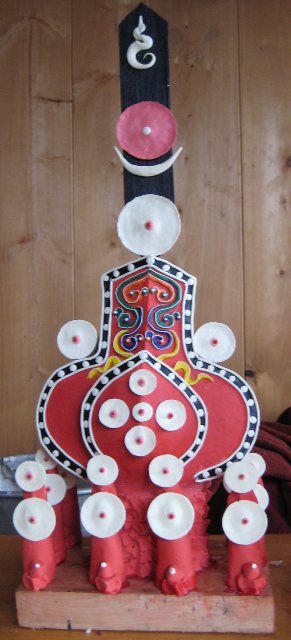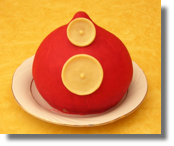Torma: Difference between revisions
No edit summary |
|||
| (9 intermediate revisions by 3 users not shown) | |||
| Line 1: | Line 1: | ||
'''Torma''' ([[ | [[Image:Kagye.jpg|thumb|400px|A [[Kagyé]] torma in preparation for the practice of [[Tendrel Nyesel]]]] | ||
'''Torma''' (Tib. གཏོར་མ་, [[Wyl.]] ''gtor ma''; Skt. ''bali'') — a ritual cake, usually hand-moulded from butter and ''[[tsampa]]'' (roasted barley flour) and coloured with dyes, which can symbolize a deity, a [[mandala]], an offering, or even a weapon. | |||
More 'permanent' tormas can be made of clay or plasticine, to which small amounts of edible substances such as ''[[amrita|düdtsi]]'' are added when they are made. Tormas are usually ornamented with ''kargyen'', 'white ornament', which are disc-like decorations of the sun and moon, four-petalled flowers, lotus bases and dissolving-point shapes known as ''nada''. | |||
== Origin == | == Origin == | ||
| Line 7: | Line 10: | ||
== Transmission Lineage == | == Transmission Lineage == | ||
The practice of offering torma has been transmitted through many lineages, but one particular lineage is as follows: [[Ananda]] transmitted to [[Nanda]], and Nanda to the [[bhikshuni]] Rati. Several [[arhat]]s received it from her and then passed it on to the yogin Antavajra, and the sages of [[Bodhgaya]]. Then it passed to [[Dharmamati]], [[Atisha]], [[Dromtönpa]] who, in turn, transmitted it to the [[Three Brothers]] (his three principal disciples—[[Potowa]], [[Chengawa Tsultrim Bar|Chengawa]] and [[Phuchungwa Shyönnu Gyaltsen|Phuchungwa]]). This is how the lineage was transmitted progressively to Tibet, the Land of Snows. | The practice of offering torma has been transmitted through many lineages, but one particular lineage is as follows: [[Ananda]] transmitted to [[Nanda]], and Nanda to the [[bhikshuni]] Rati. Several [[arhat]]s received it from her and then passed it on to the yogin Antavajra, and the sages of [[Bodhgaya]]. Then it passed to [[Dharmamati]], [[Atisha]], [[Dromtönpa]] who, in turn, transmitted it to the [[Three Brothers]] (his three principal disciples—[[Potowa]], [[Chengawa Tsultrim Bar|Chengawa]] and [[Phuchungwa Shyönnu Gyaltsen|Phuchungwa]]). This is how the lineage was transmitted progressively to Tibet, the Land of Snows. | ||
== The | == The Essence of Torma == | ||
The essence of the torma is the [[dharmadhatu]], which is the utterly pure nature of the world, and the wisdom of [[rigpa]], the completely pure nature of the [[sentient beings]] inhabiting the world—it is the indivisible union of [[emptiness]] (the object) and [[wisdom]] (the subject). | |||
The essence of the torma is the [[dharmadhatu]], which is the utterly pure nature of the world, and the wisdom of rigpa, the completely pure nature of the sentient beings inhabiting the | |||
Even though there are several categories of tormas (such as outer, inner, secret, [[dhyana]], illustrative) here we are mainly discussing the first, the outer torma. | |||
== Meaning of the Word == | |||
[[Image:Torma 1.png|frame|A [[tsok]] offering torma]] | |||
As for the term ‘torma’, Guru [[Padmasambhava]] said: | As for the term ‘torma’, Guru [[Padmasambhava]] said: | ||
| Line 27: | Line 29: | ||
*the guests invited out of respect, the [[Three Jewels]], | *the guests invited out of respect, the [[Three Jewels]], | ||
*the guests invited for their qualities, the glorious deities, | *the guests invited for their qualities, the glorious deities, | ||
*the | *the guests invited out of compassion, the beings of the [[six realms]], and | ||
*the | *the guests who are [[harmful spirit]]s (Tib. ''dön''), [[obstacle maker]]s (Tib. ''gek'') and our [[karmic creditor]]s. | ||
==Various kinds of tormas== | |||
[[Kunkyen Tenpe Nyima]] gives a brief overview of different kinds of tormas in his ''General Notes on the Rituals of the Development Stage'': | |||
:If you want to take a more elaborate approach, visualize the shrine torma (rten gtor) as the deity and maintain the visualization for as long as you render offerings to it. The perpetual torma (rtag gtor) is kept for a specific duration of months or years. The sādhana torma, (sgrub gtor) also called the offering torma (mchod gtor), is offered and received by the deities as a gift. As a means to delight them, mending tormas serve as an offering substance symbolizing sense pleasures and enjoyments. The captured torma (gta' gtor) is kept until an activity is accomplished, after which it is to be offered. The purpose of this torma is to ensure that an activity is accomplished swiftly and without delay. The session torma (thun gtor), also called the daily torma (rgyun gtor), is given occasionally in order to enjoin certain temporary activities. A simple renunciant practitioner may also make these tormas using simply the best portions of his or her own food and drink.<ref>Kunkyen Tenpe Nyima, ''The Compendium of Oral Instructions: General Notes on the Rituals of the Development Stage'', in ''Vajra Wisdom: Deity Practice in Tibetan Buddhism''. Snow Lion, 2013. </ref> | |||
==Further Reading== | |||
*[[Padmasambhava]] and [[Jamgön Kongtrül]], ''The Light of Wisdom, Vol II'', translated by [[Erik Pema Kunsang]] (Boudhanath, Hong Kong & Esby: Rangjung Yeshe, 1998), pages 128-129 & 199-200. | |||
==Notes== | |||
<small><references/></small> | |||
[[Category:Shrine and Ritual]] | [[Category:Shrine and Ritual]] | ||
Latest revision as of 04:24, 18 February 2018

Torma (Tib. གཏོར་མ་, Wyl. gtor ma; Skt. bali) — a ritual cake, usually hand-moulded from butter and tsampa (roasted barley flour) and coloured with dyes, which can symbolize a deity, a mandala, an offering, or even a weapon.
More 'permanent' tormas can be made of clay or plasticine, to which small amounts of edible substances such as düdtsi are added when they are made. Tormas are usually ornamented with kargyen, 'white ornament', which are disc-like decorations of the sun and moon, four-petalled flowers, lotus bases and dissolving-point shapes known as nada.
Origin
To trace back a particular practice or aspect of practice to the Buddha is a way to authenticate its origin, while showing that the lineage has remained uninterrupted since its inception helps give us confidence that the way we are practising today is still in accordance with the instructions of the Buddha.
The origin of the tormas we offer is described in the following account. Once, at the time of the Buddha Shakyamuni, as Ananda was practising the Dharma in the forest near the city of Kapilavastu, a frightening preta spitting fire through his mouth appeared in front of him. He told Ananda, “You have only seven days left to live, at the end of which I will eat you.” Ananda, extremely scared, ran to the Buddha and told him what had just happened. The Bhagavan replied, “Make a torma of infinite magnificence, bless it with mantra, and offer it. This will liberate you from the fear of untimely death and lead you to accomplish infinite qualities.”
Transmission Lineage
The practice of offering torma has been transmitted through many lineages, but one particular lineage is as follows: Ananda transmitted to Nanda, and Nanda to the bhikshuni Rati. Several arhats received it from her and then passed it on to the yogin Antavajra, and the sages of Bodhgaya. Then it passed to Dharmamati, Atisha, Dromtönpa who, in turn, transmitted it to the Three Brothers (his three principal disciples—Potowa, Chengawa and Phuchungwa). This is how the lineage was transmitted progressively to Tibet, the Land of Snows.
The Essence of Torma
The essence of the torma is the dharmadhatu, which is the utterly pure nature of the world, and the wisdom of rigpa, the completely pure nature of the sentient beings inhabiting the world—it is the indivisible union of emptiness (the object) and wisdom (the subject).
Even though there are several categories of tormas (such as outer, inner, secret, dhyana, illustrative) here we are mainly discussing the first, the outer torma.
Meaning of the Word

As for the term ‘torma’, Guru Padmasambhava said:
- ‘tor’ means to give without attachment, and
- ‘ma’ means completely present.
So ‘tor’ refers to giving without any attachment or grasping in the mind, and ‘ma’ to when what is given is completely present to the perception of the guests.
And who are those guests? In a nutshell they are those who are higher than us and to whom we offer, and those who are lower than us and to whom we give. To divide those two groups slightly, there are four categories:
- the guests invited out of respect, the Three Jewels,
- the guests invited for their qualities, the glorious deities,
- the guests invited out of compassion, the beings of the six realms, and
- the guests who are harmful spirits (Tib. dön), obstacle makers (Tib. gek) and our karmic creditors.
Various kinds of tormas
Kunkyen Tenpe Nyima gives a brief overview of different kinds of tormas in his General Notes on the Rituals of the Development Stage:
- If you want to take a more elaborate approach, visualize the shrine torma (rten gtor) as the deity and maintain the visualization for as long as you render offerings to it. The perpetual torma (rtag gtor) is kept for a specific duration of months or years. The sādhana torma, (sgrub gtor) also called the offering torma (mchod gtor), is offered and received by the deities as a gift. As a means to delight them, mending tormas serve as an offering substance symbolizing sense pleasures and enjoyments. The captured torma (gta' gtor) is kept until an activity is accomplished, after which it is to be offered. The purpose of this torma is to ensure that an activity is accomplished swiftly and without delay. The session torma (thun gtor), also called the daily torma (rgyun gtor), is given occasionally in order to enjoin certain temporary activities. A simple renunciant practitioner may also make these tormas using simply the best portions of his or her own food and drink.[1]
Further Reading
- Padmasambhava and Jamgön Kongtrül, The Light of Wisdom, Vol II, translated by Erik Pema Kunsang (Boudhanath, Hong Kong & Esby: Rangjung Yeshe, 1998), pages 128-129 & 199-200.
Notes
- ↑ Kunkyen Tenpe Nyima, The Compendium of Oral Instructions: General Notes on the Rituals of the Development Stage, in Vajra Wisdom: Deity Practice in Tibetan Buddhism. Snow Lion, 2013.